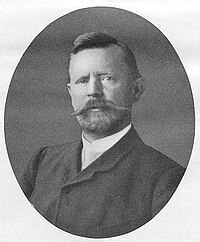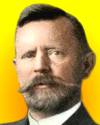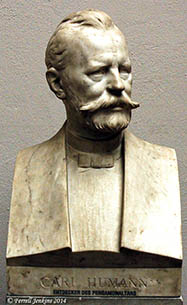Carl Humann
Carl Humann ( first name also Karl; born January 4, 1839 in Steele, today district of Essen, † April 12, 1896 in Smyrna, now Izmir ) was a German engineer, architect and archaeologist Classic. He was best known as the discoverer of the Pergamon Altar.
Life and work
Humann worked by classical humanist schooling (Abitur in 1859 at the Royal Grammar School at Castle Square to eat ) first for the Bergisch- Märkische Railway Company in 1860 and began his engineering studies at the Academy of Architecture in Berlin.
In the fall of 1861, he broke out for health reasons from his studies and followed his older brother Franz ( 1832-1893 ), who worked as a civil engineer in belonging to the Ottoman Empire Samos and Karl there promised work and archaeological operating the call. Also, in the hope of recovering from a tuberculosis disease better by the healthier climate in the Mediterranean, he landed on November 15, 1861 on the island of Samos. He participated among others in excavations of the local Heraions and ancient palaces. Humann remained in the Ottoman Empire and worked on as a civil engineer. In 1864 he traveled on behalf of the Ottoman government Palestine to level the land and to make an accurate map of the country. Similarly, he later explored the eastern Balkans and took on a map. In preparation for future excavations he also visited the ancient site of Pergamon in the winter of 1864 /65. At the well-known historical, but not yet excavated site he first used his influence to prevent the destruction of the partially exposed marble ruins in lime kilns as far as possible. But for a full excavation was lacking support from Berlin.
In Asia Minor Humann conducted from 1867 to 1873 together with his brother Franz building roads. From 1868, he lived in Bergama, the former Pergamon, and continued his archaeological studies there continues especially in the winter months. He stood in contact with the cartographer Heinrich Kiepert and Ernst Curtius, the director of the Berlin Collection of Classical Antiquities. However, in view taken excavations in Pergamon initially did not materialize because Curtius, the excavation in Olympia turned. After adjustment of the road project Humann lived from 1873 as a civil engineer in Smyrna, interrupted by a trip to Germany 1873/74, where he married.
Only in 1878 had Humann both financial backing by the director of Berlin Sculpture Museum, Alexander Conze, as well as the official excavation permit from the Ottoman side, and on September 9, began the first year-long excavations on the acropolis of Pergamon. Large parts of the extraordinary artistic valuable frieze of the Pergamon Altar and numerous sculptures were already Unexpectedly on September 12 found. By the end of September 1878 twenty-three groups of ancient gigantomachy were already exposed. Further excavations took place in the years 1880-1881 and 1883-1886. The findings, which tion states according to an agreement with the Ottoman Empire of the German side, were transported by oxcart to five hours from the coast, where they were loaded on ships of the German Navy and taken to Berlin. In the German Reich it was soon the sensational significance of the find, Humann was a celebrity and in 1879 a full member of the German Archaeological Institute, 1889 Honorary Doctorate in Greifswald. Especially against the background of the nationalist mindset of that era people were proud, for example, to the Parthenon frieze of the British Museum in London to oppose something.
On behalf of the Berlin Academy of Sciences made Humann archaeological recordings of the ancient sites of Angora, on the upper Euphrates and in northern Syria. In the summer of 1882 he dug for the German Oriental Society in Bogazköy and Yazilikaya, while his friend, the director of the Ottoman museums Hamdi Bey, first excavations in Zincirli ( Sam'al ) began. Humann 1883 accompanied the professor of archeology Otto Puchstein on his expedition to explore the sites of ancient Commagene to excavation areas on the Euphrates. They arrived in May the ruins of Gaziantep and made sketches of the grave sanctuary of Sesönk. On June 1 Samosata was explored and the group reached the ultimate goal of the expedition, the Hierothesion on 7 June 1883 on the Nemrut Dağ, which was first photographed and measured for science.
1884 Humann was appointed Division Director of the Royal Museums in Berlin, but retained as foreign director resident in Smyrna, to safeguard the interests of the royal museums in the Orient. He worked and researched further and received in his well-known house numerous guests. In 1887, he led topographical studies in Hierapolis by 1888 it continued the excavations of Zincirli in northern Syria and made a trial excavation in Tralles.
Between 1891 and 1893 dug Humann from Magnesia on the Meander, from 1894 he also participated in the first Austrian excavations in Ephesus. In September 1895 he also began an excavation in Priene, supported by the young fellows and friend Theodor Wiegand, who continued Humann factory and from 1899 also directed the excavations at Miletus. On October 5, had Humann, suffering from a severe liver disease, leave unto Smyrna, and Wiegand handed the lead in Priene. Carl Humann died on April 12, 1896 in Smyrna and was buried in the local cemetery.
One of Adolf Brütt 1901 created portrait bust Humann came to the associated with the completion of Siegesallee opening of the first Berlin's Pergamon Museum. A copy of this bust is located on the Emperor Otto place in Steele. Named after Humann are the Carl- Humann -Gymnasium in Essen- Steele and Carl - Humann - School in Berlin. 1963, the Catholic cemetery at Smyrna was abandoned, Humann remains were then transferred to the acropolis of Pergamon and 1967 buried under the leadership of Erich Boehringer in a newly inaugurated tomb.
Family
Humann parents, the innkeeper Franz Wilhelm Humann (1806-1870) and Maria Catharina from scours (1805-1887), had married on October 11, 1831 in Steele. On January 21, 1832, the eldest son Franz, 1839 Charles, 1841 and 1843 Theodor Wilhelm was born. In the years 1845 and 1850, the birth of daughters Caroline and Marie followed. On November 24, 1874 Carl Humann married in the registry office Wattenscheider Werwer Louise ( 1843-1928 ), daughter of the manor farmer Heinrich Werwer in Sevinghausen and Anna Maria Borgwarth. From Humann marriage four children: daughter Mary Humann (1875-1971), the archaeologist Friedrich Sarre married in 1901, died in 1878, a one year old daughter, the son of Hans Humann ( 1878-1933 ), who as a naval officer, diplomat and businessman was known, and in 1889 seven year old deceased son Charles.
Writings
- Travel in Asia Minor and northern Syria. Edited together with O. Puchstein ( with Atlas ). Reimer, Berlin 1890 (online).
- Magnesia on the Meander. Reimer, Berlin 1904 ( online).










